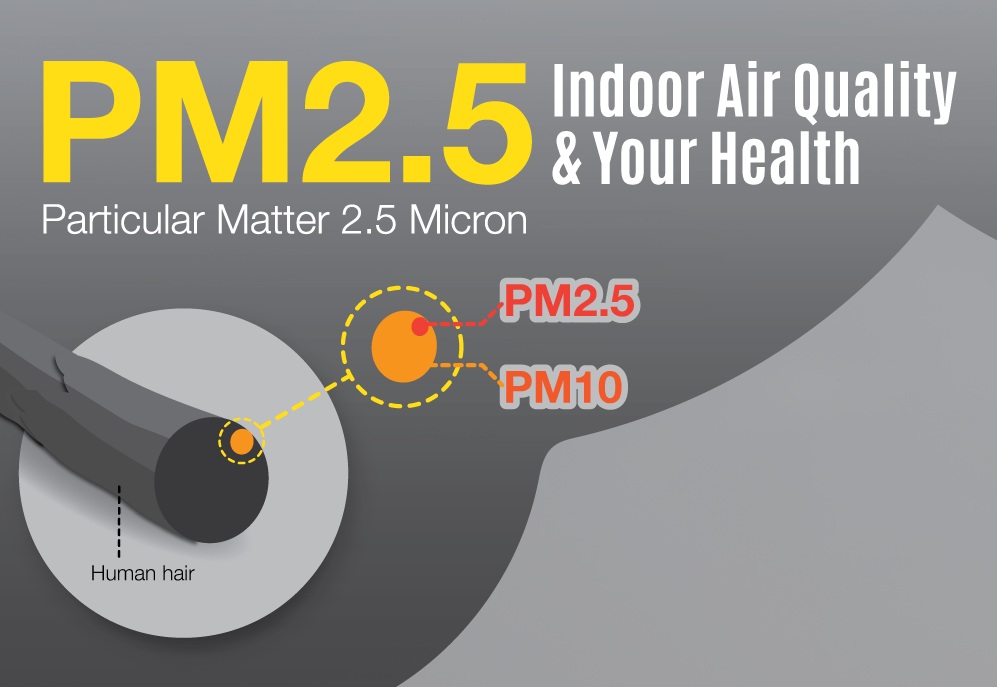What Is PM 2.5 & How Can You Reduce Your Exposure?
You may have heard about PM 2.5 every year in winters, or even on the news as part of coverage of wildfires or other air pollution events. High levels of PM 2.5 can have serious health consequences for you and your family. But what does this term mean, and how is it linked to respiratory disease, heart attack and other health problems? And more importantly, how can you reduce your exposure to it?
What is PM 2.5?
PM 2.5 refers to a category of particulate pollutant that is 2.5 microns or smaller in size. The average cross-section of a human hair is 50 microns. PM stands for “particulate matter.” The health organizations categorize particulate matter by size because different size particles have different health effects. For instance, PM 10 particles (particles less than 10 microns in size) can irritate your nose and eyes, but fewer of these particles penetrate deep into your lungs, so they do not cause the same health problems that smaller micron particles can, although they do increase rates of respiratory disease.
How can PM2.5 affect my health?
Particles in the PM2.5 size range are able to travel deeply into the respiratory tract, reaching the lungs. Exposure to fine particles can cause short-term health effects such as eye, nose, throat and lung irritation, coughing, sneezing, runny nose and shortness of breath. Exposure to fine particles can also affect lung function and worsen medical conditions such as asthma and heart disease. Scientific studies have linked increases in daily PM2.5 exposure with increased respiratory and cardiovascular hospital admissions, emergency department visits and deaths. Studies also suggest that long term exposure to fine particulate matter may be associated with increased rates of chronicbronchitis, reduced lung function and increased mortality from lung cancer and heart disease. People with
breathing and heart problems, children and the elderly may be particularly sensitive to PM2.5.
Where does PM2.5 come from?
There are outdoor and indoor sources of fine particles. Outside, fine particles primarily come from car,truck, bus and off-road vehicle (e.g., construction equipment, snowmobile, locomotive) exhausts, other
operations that involve the burning of fuels such as wood, heating oil or coal and natural sources such as forest and grass fires. Fine particles also form from the reaction of gases or droplets in the atmosphere
from sources such as power plants. These chemical reactions can occur miles from the original source of the emissions. In State like Delhi, some of the fine particles measured in the air are carried by wind from
out-of-state sources. Because fine particles can be carried long distances from their source, events such as wildfires or volcanic eruptions can raise fine particle concentrations hundreds of miles from the event.
PM2.5 is also produced by common indoor activities. Some indoor sources of fine particles are tobacco smoke, cooking (e.g., frying, sautéing, and broiling), burning candles or oil lamps, and operating fireplaces
and fuel-burning space heaters (e.g., kerosene heaters).What can I do to reduce my exposure to fine particle pollution when levels are extremely high? Stay indoors in an area with filtered air. Particle pollution can get indoors, so consider purchasing an air cleaner if you live in an area with high levels of particle pollution. Air cleaners that remove particles include high-efficiency mechanical filters and electronic air cleaners, such as
electrostatic precipitators. Avoid using an air cleaner that works by generating ozone, which will increase the pollution in your home. If you do not have air cleaners in your home, try to go somewhere that does have air
filtration. This could, for example, be a friend’s home, if it has air filtration. Keep your activity levels low. Avoid activities that make you breathe faster or more deeply. This is a good day for indoor activities, such as
reading or watching TV.If you cannot buy filters for your entire home, create a clean room for sleeping. Run an air conditioner or central air conditioning system if you are certain your air conditioner does not draw
air from outdoors and has a filter. If the air conditioner provides a fresh air option, keep the fresh-air intake closed. Make sure that the filter is clean enough to allow good air flow indoors. Take additional steps to keep pollution in your home low. Air cleaners alone may not be enough. Because particle pollution from the outdoor air can easily get inside, take steps to avoid adding even more pollution indoors when outdoor PM2.5 levels are high. Avoid using anything that burns, such as wood fireplaces, gas logs and even candles or incense. Keep the room clean – but don’t vacuum unless your vacuum has a HEPA filter. That stirs up particles already inside your home. Wet mopping can help reduce dust.Don’t smoke. When air quality improves, open the windows and air out your home or office. Selecting an air cleaner: Air cleaners that remove particles include high-efficiency mechanical filters and electronic air cleaners,such as electrostatic precipitators. Avoid using an air cleaner that works by generating ozone, which will increase the pollution in your home.










